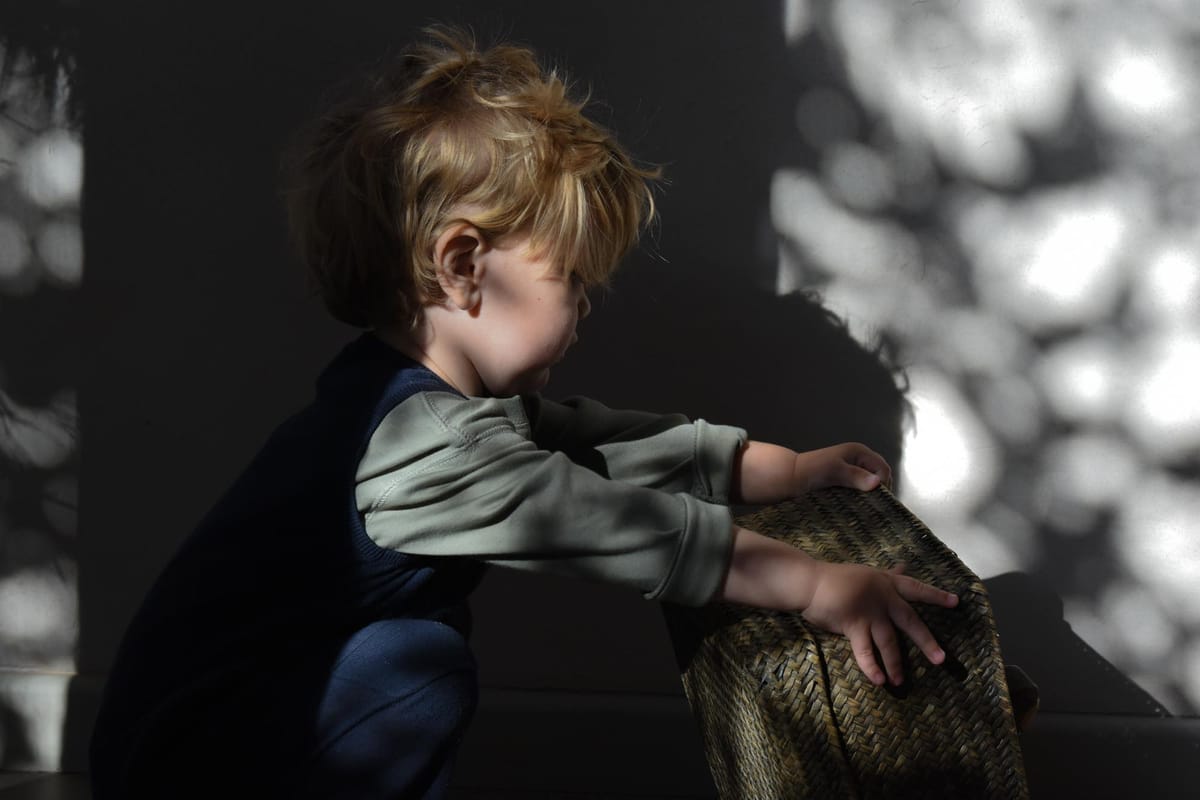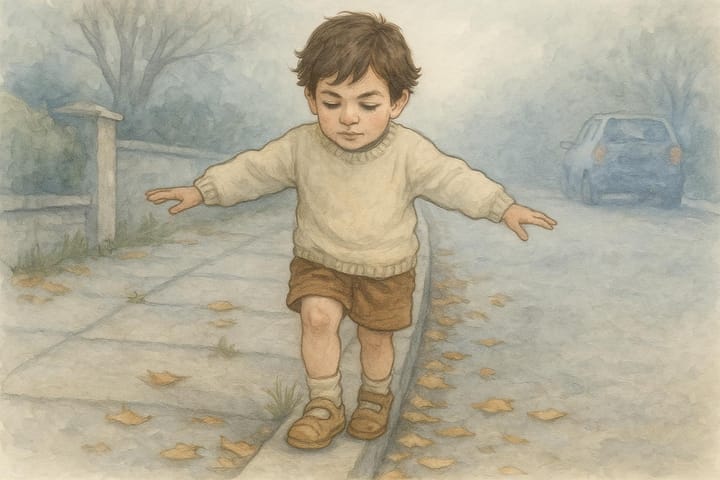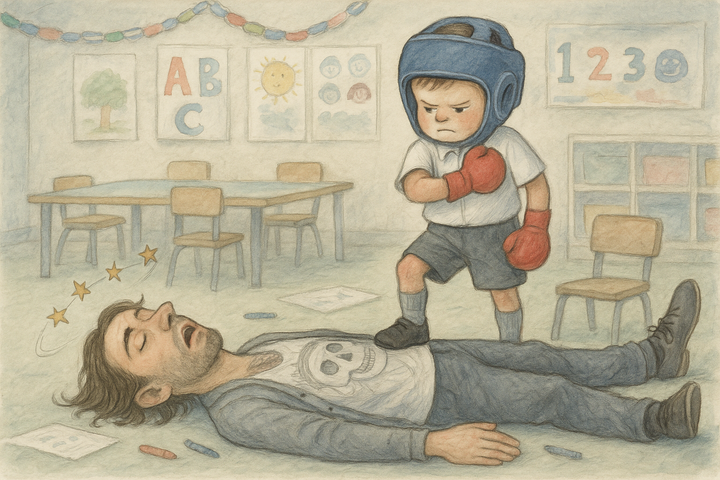Get set for discovery with Play Kits for schemas
Who needs toys when you can get a childhood's worth of fun from a few everyday things.

Here is a boy.
He has been here some time.
His plan didn't quite work and he is deep in thought - but he is not giving up.
The basket is empty, but not empty of promise. It calls to the him. What can you do with me? Hide under me? Fill me? Stack me?
But the boy has other ideas. Going over to the sideboard he returns with another basket, much like the first, but smaller.
He drops it in and pauses. It doesn't look right.
So now a third basket, medium-sized.
After a pause, he slips it in. Yes! It fits! And perfectly, too!
That was you cheering; the boy simply notes his success with quiet satisfaction. And then, with renewed conviction, he puts the third one back in and now all is revealed: three nested baskets.
He is exploring the containing schema, the idea that things fit inside. It's a key concept for a toddler. And these stacking boxes have introduced seriation, too, the idea that some things must be done in the right order. He'll make use of this knowledge when he learns to count.
But that's a long way off. Today, he is simply having fun.
And you won't easily drag him away.
didactic materials
It couldn't be more fun!
It's a theme he will return to again and again. There are many subtleties to master.
Is your child endlessly fascinated by stacking, dropping, or wrapping objects? Harness her natural curiosity by creating a schema play kit! This guide will help you assemble a collection of everyday items that encourage exploratory play aligned with various schemas. Let’s dive in and build play kits that turn ordinary household objects into extraordinary learning tools.
The general schema play kit
A general schema play kit is a treasure trove of items that offer endless possibilities for play. These objects have high play potential, meaning they can be used in multiple ways across different types of schema play.
Essential items for your play kit
- Cardboard boxes. A variety of sizes for building, stacking, and enclosing.
- Wooden blocks. Perfect for construction, positioning, and enclosing play.
- Scarves and fabric. Great for enveloping, wrapping, or dressing up.
- Balls. Various sizes and textures for rolling, bouncing, and trajectory play.
- Plastic containers and lids. Useful for posting, transporting, and enclosing.
- String and yarn. Ideal for connecting, tying, and weaving activities.
- Clothes pegs and paper clips. Good for connecting and positioning.
- Toy cars and trains. Excellent for transporting, trajectory, and connecting play.
- Rubber bands. Great for connecting and experimenting with elasticity.
- Spoons, cups, and funnels. Perfect for pouring, scooping, and transporting.
These items are open-ended, allowing your child to use them creatively as she explores different schemas. Now, let’s tailor specific play kits for each schema.
Mini play kits for each schema
Trajectory play kit
Items needed:
- Balls of different weights and sizes
- Paper aeroplanes or materials to make them
- Balloons
- Water sprayers or spray bottles
- Ramps made from planks or cardboard
Play ideas:
- Set up a ramp and roll balls down to observe how far they go.
- Use spray bottles to see how water arcs through the air.
- Make and fly paper aeroplanes, adjusting designs to see how flight paths change.
Connecting play kit
Items needed:
- String, yarn, and ribbon
- Tape and glue sticks
- Paper clips and bulldog clips
- LEGO or building blocks
- Velcro strips
- Rubber bands
Play ideas:
- Create chains using paper clips or by linking rubber bands.
- Build structures with blocks and see how high they can go before collapsing.
- Use tape and string to connect various household items in inventive ways.
Transporting play kit
Items needed:
- Buckets and baskets
- Old handbags or backpacks
- Toy carts or strollers
- Spoons and scoops
- Small items like stones, pinecones, or beans
Play ideas:
- Organise a treasure hunt where your child collects items in a basket.
- Set up a pretend delivery service using backpacks and toy carts.
- Use spoons to transfer beans from one container to another, enhancing fine motor skills.
Enclosing play kit
Items needed:
- Blocks or small boxes for building walls
- Hula hoops
- Chalk for drawing boundaries
- String to outline areas
- Plastic tubes or PVC pipes
Play ideas:
- Build enclosures for toy animals using blocks.
- Draw circles or squares on the ground and place objects inside them.
- Use hula hoops to define personal play spaces.
Enveloping play kit
Items needed:
- Scarves, fabric pieces, and blankets
- Wrapping paper and newspaper
- Old clothes for dressing up
- Pillowcases or cloth bags
- Aluminium foil and wax paper
Play ideas:
- Wrap toys or household items like gifts.
- Dress up in layers of clothing or play peek-a-boo with scarves.
- Create secret parcels by wrapping objects and letting your child guess what’s inside.
Rotation play kit
Items needed:
- Spinning tops
- Wheels from old toys
- Rolling pins
- Pot lids (round ones)
- Lazy Susan turntables
Play ideas:
- Explore how different objects spin and what affects their speed.
- Use a rolling pin with playdough to observe the rolling motion.
- Spin pot lids on the floor and watch how they move.
Positioning play kit
Items needed:
- Sorting trays or egg cartons
- Collections of similar items (buttons, stones, shells)
- Sticky notes
- Rulers or measuring tapes
- Picture frames for arranging displays
Play ideas:
- Sort objects by colour, size, or shape into trays.
- Line up toys in a sequence or pattern.
- Create art by positioning sticky notes in designs on a wall.
Orientation play kit
Items needed:
- Periscopes or kaleidoscopes
- Mirrors
- Stepping stools or safe climbing structures
- Magnifying glasses
- Camera (child-friendly)
Play ideas:
- Use mirrors to explore reflections from different angles.
- Climb on stools to see how the room looks from a higher perspective.
- Take photos of familiar objects from unusual angles.
Bonus: play kits for lesser-known schemas
Transformation play kit
Items needed:
- Playdough or clay
- Ice cubes and warm water
- Food colouring and mixing bowls
- Old magazines for cutting and pasting
Play ideas:
- Mix colours in playdough to see new colours form.
- Melt ice cubes in warm water and observe the change.
- Create collages by transforming magazine pictures.
Scattering play kit
Items needed:
- Confetti or hole-punched paper dots
- Sand or rice
- Feathers or leaves
- Bubbles
Play ideas:
- Scatter confetti and see how it falls.
- Blow bubbles and chase them as they scatter in the wind.
- Throw leaves into the air and watch them drift down.
Posting play kit
Items needed:
- Cardboard tubes with slots cut into them
- Envelopes and junk mail
- Coins and piggy banks
- Small balls and containers with holes
Play ideas:
- Create a homemade mailbox and "post" letters.
- Drop coins into a piggy bank, listening to the sounds they make.
- Push small balls through holes cut into boxes.
Disconnecting play kit
Items needed:
- Snap beads
- Velcro strips
- Interlocking blocks
- Simple nuts and bolts
- Zippers and buttons on old clothing
Play ideas:
- Assemble and disassemble snap beads or blocks.
- Practise unzipping zippers and unbuttoning buttons.
- Use nuts and bolts to connect and disconnect parts.
Final word
Play kits are more than just a collection of objects - they are a gateway to deep, meaningful play. By aligning materials with your child’s natural instincts and developmental interests, you are setting her up for independence, creativity, and focus.
As your child grows, so will her play kits. What starts as a simple box of materials will evolve into a living resource that she returns to time and time again, each time engaging in more complex and imaginative ways. Over time, she will take ownership - adding new objects, experimenting with ideas, and even designing her own play kits.
If you are just starting out, begin with a general schema play kit and observe how your child interacts with different materials. From there, you can introduce new play kits, one at a time, to support her evolving interests.
Your child’s ability to play independently is not a fixed trait - it is a habit that can be nurtured. By making schema play kits easily accessible, you create an environment where play is the obvious and natural choice.
What will your first play kit be?



Comments ()